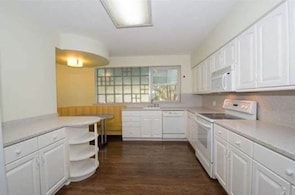
Before you decide to take down a wall. Non-load-bearing walls may require a more invasive approach. Blasting them down with hammers is dangerous and can cause damage. It's better to remove walls in layers, similar to peeling onions. Before you can remove any items inside the wall, first remove the drywall. Once you're done, take out the existing studs.
Before you start, make sure that the wall is load-bearing. This can be a difficult task if the wall is constructed of bricks. In such cases, you will require a structural engineer’s report. The next step will be to determine if the wall has any plumbing in it. If so, you will need to reroute the pipes and electrical outlets. It can be dangerous to remove load-bearing walls.

If you're renovating an old house, it may be time to knock down a wall. This can be a great way to create more space in your home and make your home more inviting. You can then start to design a new layout. You can increase the space in your home by removing walls. Remember to protect your property. Consider the effect of tearing down a space on the surrounding property.
Before you begin tearing down a building, identify whether it is load-bearing. You can usually tell whether or not a particular wall is load-bearing by examining it closely. You can also check for drains in basements or crawlspaces if you are working on a second-floor. After that, you can begin removing walls. This is a great way of opening up the space and letting more light in.
Before you remove a wall, make sure you check for plumbing. Examining the wall closely will help you determine whether it is load-bearing. Sinks often have drains hidden in the walls. Make sure to check the pipes underneath them and make sure they are flowing freely. You should also make sure to shut off the water and power mains if they are in the crawlspace.

Before you start tearing down a wall in a crawlspace, turn off the water supply. If you're tearing down a wall in a crawlspace, be sure to consider the plumbing. For example, if the toilet or sink are blocked, it may be a load bearing wall. You can also check for other plumbing connections if you are removing a wall from the second floor. You might also check your crawlspace.
FAQ
How should home renovations take place?
The first thing you need to do when renovating your home is to decide where you want to put everything. You should consider how you want to market your home to potential buyers if you are planning to sell your house soon. The next step is to plan the layout of your living, kitchen, and bathroom. After you have selected the rooms you wish to renovate you can begin searching for contractors who specialize. After you have hired a contractor to work on your project, it is time to get started.
How do I select a competent contractor?
When choosing a contractor, ask friends and family members for recommendations. Also, look at online reviews. You should ensure that the contractor you select has experience in the field of construction you are interested. Refer to previous clients and verify their references.
How can you remodel a house without spending any money?
Here are some tips to help you renovate your home without spending too much money.
-
You should create a budget plan
-
Find out what materials are required
-
You must decide where to place them
-
Make a list with the items you need to purchase
-
How much money do you have?
-
Plan your renovation project
-
Start to work on your plans
-
Do your research online
-
Ask family members and friends for help
-
Get creative
How much does it take to renovate a home?
Renovations are usually between $5,000 and $50,000. Renovations typically cost homeowners between $10,000 and $20,000
Is it more expensive to remodel an existing house than to build one new?
Two options are available to those who want to build a home. You can buy a pre-built house. This home is ready for you to move into. You can also build your own home. This option will require you to hire a builder in order to design and build your dream house.
How much time and effort you put into designing and planning your new home will determine the cost. Because you will likely be doing most of the work yourself, a custom home can require more effort. But, you also have more control over which materials you choose and where you place them. It may be easier to find a contractor who is skilled in building custom homes.
A new home is typically more expensive than one that has been renovated. You'll have to pay more for land and any improvements. Plus, you'll need to pay for permits and inspections. The average price difference between a new home and one that has been renovated is between $10,000 and $20,000.
What are my considerations when purchasing a new house?
Be sure to have enough money in reserve for closing costs before you purchase a new home. If you don't have enough cash on hand, then you might want to think about refinancing your mortgage.
Can I renovate my whole home myself?
If you are able to do it yourself, why not pay someone else?
It doesn't matter how much you love DIY, there are times when you simply cannot do it yourself. There could be too many variables to manage.
For example, if you live in an old home, you might find that the wiring is outdated and you would need to hire a qualified electrician to make sure that your electrical system is safe and reliable.
Be aware that structural damage might be too costly for you to repair during the renovation.
You may not have the proper tools to complete the job. For instance, if you are planning to install a new kitchen sink, you'll need to buy a special tool called a plumber's snake which is used to clear clogged pipes.
You must also follow plumbing codes to ensure that a licensed plumber is working on your project.
The bottom line is that you need to know exactly what you are capable of doing before you embark on such a big task.
If you are unsure whether you can tackle the job yourself, ask for help from friends and family members who have done similar projects before.
They can help you determine the right steps and where you can find out more.
Statistics
- Design-builders may ask for a down payment of up to 25% or 33% of the job cost, says the NARI. (kiplinger.com)
- A final payment of, say, 5% to 10% will be due when the space is livable and usable (your contract probably will say "substantial completion"). (kiplinger.com)
- The average fixed rate for a home-equity loan was recently 5.27%, and the average variable rate for a HELOC was 5.49%, according to Bankrate.com. (kiplinger.com)
- On jumbo loans of more than $636,150, you'll be able to borrow up to 80% of the home's completed value. (kiplinger.com)
- According to the National Association of the Remodeling Industry's 2019 remodeling impact report , realtors estimate that homeowners can recover 59% of the cost of a complete kitchen renovation if they sell their home. (bhg.com)
External Links
How To
How do you renovate an old house?
Before you start, it is essential that you decide which type of renovation project to undertake. This could be anything from updating your kitchen appliances to completely renovating the house.
Once you have decided what type of renovations you want to undertake, the next step is to determine how much money it will cost. You might discover that you don't have enough funds for the entire project. This is a sign that you may not have enough funds to cover the entire cost of the project.
Before you make the decision to carry out renovations, there are some things that you should do. You must ensure you have all the permits needed for the job. You might also need to check whether you need planning permission for certain types or work. If you are planning to make extensions to your house, you may need to apply to the building consent.
Before you start working on the house, it's always best to check the local council website to see if they require any additional permits. It is also important to check whether planning permission is required for every part of the house you are renovating. If you plan to do major renovations, such as replacing a roof, it is advisable to consult your insurance provider to ensure that you have sufficient coverage.
Next is choosing the right tools for the job. There are many different options available, so it's important to take your time to research them thoroughly. You will use paint, wallpaper paste or flooring for your renovations.
It is important to evaluate the quality of these items when you are shopping for them. Low quality products are more likely to be thrown away after a while, while high-quality products last for a longer time and offer better value. When purchasing any product, make sure you purchase the correct amount. Don't purchase too much as it can lead to waste of resources and the need for a lot of material. Instead, purchase only what you need.
Finally, once you've chosen the right materials for the job, you need to figure out where you'll store them while you're working on the property. If you're planning on renovating a large space of your house, you might need storage space. You could also ask your family or friends for help moving the items.